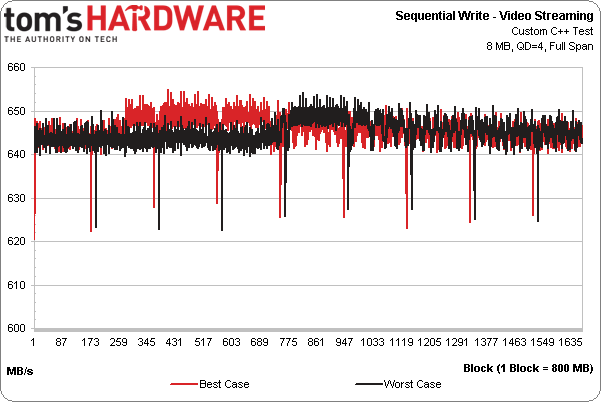Micron P420m SSD Review: 1.4 TB Of PCI Express-Attached Storage
After the success of its P320h, Micron is following up with the P420m, an MLC-based PCI Express x8 add-in card aimed at more read-oriented enterprise customers. How does it compare to the company's SLC-based flagship? We benchmark ours thoroughly.
Results: Enterprise Video Streaming Performance
Video streaming is a demanding workload within the enterprise space. Companies want more HD streams with higher bit-rates and no stuttering. A storage solution well-suited for enterprise-class video delivery has completely different capabilities than something designed for databases. At the end of the day, you're basically looking for exceptional large-block sequential write performance. You also need a high level of consistency that traditionally isn't seen from consumer SSDs. For a more in-depth analysis, take a look at page 10 of Intel SSD 910 Review: PCI Express-Based Enterprise Storage.
Once the drive is in a steady state, we write its entire capacity 100 times. We use 8 MB transfer sizes and a queue depth of four, recording timestamps for each individual write. The graph below reflects 100-point averaging, so that you can better visualize the results.
After 100 runs, there wasn't much of a difference between the best and worst. Both are well above the drive's specification. Those few dips that fall below would only require a few megabytes of buffer to overcome. Overall, the consistency is very impressive, but because the maximum sequential write speed is so low, we're left wanting more.
These results were only achieved after a lot of troubleshooting. Initially, we were seeing 800-1000 ms delays, from five to 30 times during every write. That's the sort of catastrophic failure that plagued the SSD business years ago. We tried multiple Intel motherboards and different test utilities, come up with the same numbers each time. We kept in constant contact with Micron, which provided much-appreciated support. Although we can't point our finger at a specific cause, it might be related to PCIe power states. When we added another PCIe device, the dips went away. Given that other devices (even Micron's P320h) didn't have any issues in the same configuration, we're not ready to rule out driver issues, either.
Get Tom's Hardware's best news and in-depth reviews, straight to your inbox.
Current page: Results: Enterprise Video Streaming Performance
Prev Page Results: Sequential Performance Next Page Micron P420m: A PCIe-Based SSD Built For Read-Heavy Workloads-
merikafyeah Seems like enterprise non-volatile storage is finally starting to approach the speeds of comsumer ram drives:Reply
http://www.thessdreview.com/our-reviews/romex-fancycache-review-ssd-performance-at-13gbs-and-765000-iops-in-60-seconds-flat/
Considering that the cost/GB of RAM is about $7/GB, it may not be such a bad idea to use RAM storage + backup generators instead of traditional non-volatile flash nand. -
rezzahd Maybe once the price drops I would pick one of these up, but I think we all know it will be a while before that happens.Reply -
BasslineJunkie Reply
Same here. I love the concept but price/gb isn't where it should be. But i do have some extra pci express slots that need filled!11507252 said:Maybe once the price drops I would pick one of these up, but I think we all know it will be a while before that happens.
-
utomo It is good to see good competition like now. keep comparing like this and hope soon we will get the good mature technology. now the SSD still have many improvement ideas. manufacturer need to work harder to win the market which is big.Reply -
ACTechy Awesome. Later down the road, when the price falls, these are going to be the thing to have. Really like PCI based SSD.Reply -
urbanman2004 TL;DR. I could benefit from something like this saving space on my system. It must have a hefty priceReply
